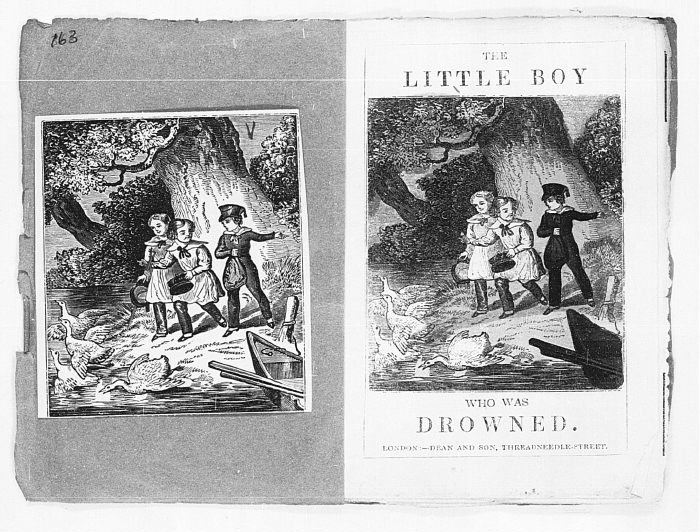Stories Before 1850. 0163: Anon., The Little Boy who was Drowned
| Author: |
Anon. |
| Title: |
The little boy who was drowned |
| Cat. Number: |
0163 |
| Date: |
No date |
| 1st Edition: |
|
| Pub. Place: |
London |
| Publisher: |
Dean and Co. |
| Price: |
Unknown |
| Pages: |
1 vol., 13pp. |
| Size: |
15 x 9 cm |
| Illustrations: |
Frontispiece plus ten further coloured engravings |
| Note: |
Additional, uncoloured illustrations are pinned into the book |
Images of all pages of this book

Introductory essay
As its title indicates, The Little Boy Who was Drowned is a cautionary tale without a happy ending. There is very little in the book, indeed, which is extraneous to the plot. Richard Williams goes off to school with his parents injunctions not to go near the river still ringing in his ears. He forgets their commands, however, and chases some geese down to the river. There he spies a boat, and cannot resist climbing on board and letting loose the mooring rope. Then the focus of the narrative switches to Richard's family who become increasingly distracted when he does not return from school where he should have spent the day. Their agonies, and especially the grief of his mother, are described at some length, the intention being to increase the reader's horror at Richard's sinfulness. The next time we see him, he is dead, his body having been found floating in the river. The copse is described, and the sense of grief is deepened yet further with the reflection that 'the very last thing he had done before his spirit left this world, was to break a commandment of God, which says - "Honour thy father and they mother..."' (pp.12-13).
The high-quality coloured engravings which adorn the book seem somehow out of place in such a gloomy work, although they faithfully depict all the vicissitudes of the story. A second, uncoloured set of prints is pinned into the book. We can speculate that this might have been a deliberate selling point of the book, the idea being that children would be able to colour the additional set themselves. Several books in the Hockliffe Collection share this trait.



